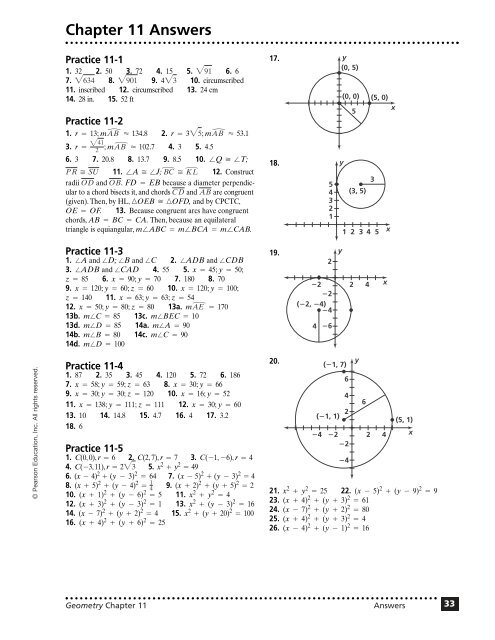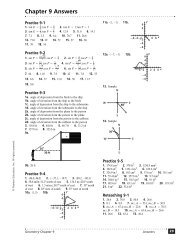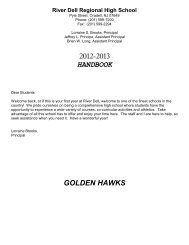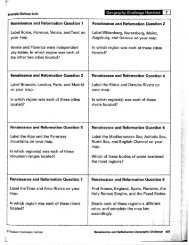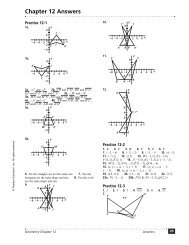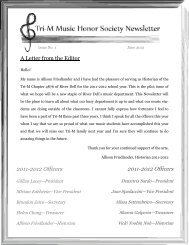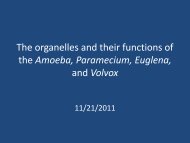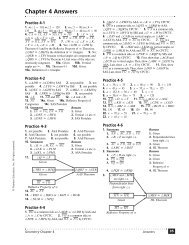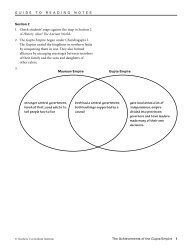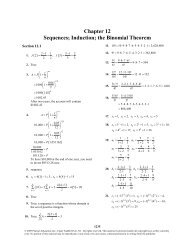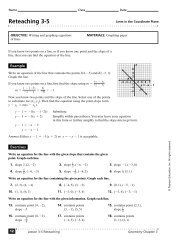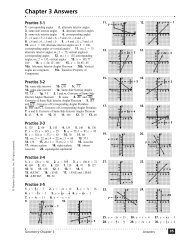Chapter 11 Answers
Chapter 11 Answers
Chapter 11 Answers
You also want an ePaper? Increase the reach of your titles
YUMPU automatically turns print PDFs into web optimized ePapers that Google loves.
<strong>Chapter</strong> <strong>11</strong> <strong>Answers</strong><br />
Practice <strong>11</strong>-1<br />
1. 32 2. 50 3. 72 4. 15 5. "91 6. 6<br />
7. "634 8. "901 9. 4"3<br />
10. circumscribed<br />
<strong>11</strong>. inscribed 12. circumscribed 13. 24 cm<br />
14. 28 in. 15. 52 ft<br />
Practice <strong>11</strong>-2<br />
0<br />
0<br />
1. r = 13; mAB<br />
134.8 2. r = 3 "5;mAB<br />
53.1<br />
#41 0<br />
3. r =<br />
2 ; mAB<br />
102.7 4. 3 5. 4.5<br />
6. 3 7. 20.8 8. 13.7 9. 8.5 10. Q T;<br />
0 0<br />
PR SU <strong>11</strong>. A J; BC KL 12. Construct<br />
radii OD and OB. FD = EB because a diameter perpendicular<br />
to a chord bisects it, and chords CD and AB are congruent<br />
(given). Then, by HL, OEB OFD, and by CPCTC,<br />
OE = OF. 13. Because congruent arcs have congruent<br />
chords, AB = BC = CA. Then, because an equilateral<br />
triangle is equiangular, mABC = mBCA = mCAB.<br />
17.<br />
18.<br />
5<br />
4<br />
3<br />
2<br />
1<br />
y<br />
(0, 5)<br />
(0, 0) (5, 0)<br />
x<br />
5<br />
y<br />
3<br />
(3, 5)<br />
1 2 3 4 5 x<br />
Practice <strong>11</strong>-3<br />
1. A and D; B and C 2. ADB and CDB<br />
3. ADB and CAD 4. 55 5. x = 45; y = 50;<br />
z = 85 6. x = 90; y = 70 7. 180 8. 70<br />
9. x = 120; y = 60; z = 60 10. x = 120; y = 100;<br />
z = 140 <strong>11</strong>. x = 63; y = 63; z = 54<br />
0<br />
12. x = 50; y = 80; z = 80 13a. m AE = 170<br />
13b. mC = 85 13c. mBEC = 10<br />
13d. mD = 85 14a. mA = 90<br />
14b. mB = 80 14c. mC = 90<br />
14d. mD = 100<br />
19.<br />
4<br />
2<br />
2<br />
2<br />
(2, 4)<br />
4<br />
6<br />
y<br />
2 4<br />
x<br />
© Pearson Education, Inc. All rights reserved.<br />
Practice <strong>11</strong>-4<br />
1. 87 2. 35 3. 45 4. 120 5. 72 6. 186<br />
7. x = 58; y = 59; z = 63 8. x = 30; y = 66<br />
9. x = 30; y = 30; z = 120 10. x = 16; y = 52<br />
<strong>11</strong>. x = 138; y = <strong>11</strong>1; z = <strong>11</strong>1 12. x = 30; y = 60<br />
13. 10 14. 14.8 15. 4.7 16. 4 17. 3.2<br />
18. 6<br />
Practice <strong>11</strong>-5<br />
1. C(0, 0), r = 6 2. C(2, 7), r = 7 3. C(-1, -6), r = 4<br />
4. C(-3, <strong>11</strong>), r = 2"3<br />
5. x 2 + y 2 = 49<br />
6. (x - 4) 2 + (y - 3) 2 = 64 7. (x - 5) 2 + (y - 3) 2 = 4<br />
8. (x + 5) 2 + (y - 4) 2 1<br />
= 9. (x + 2) 2 + (y + 5) 2 = 2<br />
10. (x + 1) 2 + (y - 6) 2 4<br />
= 5 <strong>11</strong>. x 2 + y 2 = 4<br />
12. (x + 3) 2 + (y - 3) 2 = 1 13. x 2 + (y - 3) 2 = 16<br />
14. (x - 7) 2 + (y + 2) 2 = 4 15. x 2 + (y + 20) 2 = 100<br />
16. (x + 4) 2 + (y + 6) 2 = 25<br />
20.<br />
(1, 7)<br />
(1, 1)<br />
4<br />
6<br />
4<br />
2<br />
2<br />
2<br />
4<br />
21. x 2 + y 2 = 25 22. (x - 5) 2 + (y - 9) 2 = 9<br />
23. (x + 4) 2 + (y + 3) 2 = 61<br />
24. (x - 7) 2 + (y + 2) 2 = 80<br />
25. (x + 4) 2 + (y + 3) 2 = 4<br />
26. (x - 4) 2 + (y - 1) 2 = 16<br />
y<br />
6<br />
2 4<br />
(5, 1)<br />
x<br />
Geometry <strong>Chapter</strong> <strong>11</strong> <strong>Answers</strong> 33
<strong>Chapter</strong> <strong>11</strong> <strong>Answers</strong> (continued)<br />
Practice <strong>11</strong>-6<br />
1.<br />
<strong>11</strong>.<br />
2 cm<br />
Q<br />
T<br />
2.<br />
1.5 cm<br />
1 in.<br />
12.<br />
R<br />
0.75 in.<br />
S<br />
0.75 in.<br />
3.<br />
P<br />
Q<br />
13.<br />
T<br />
U<br />
0.5 cm<br />
14.<br />
A<br />
B<br />
5 mm<br />
6 mm<br />
4.<br />
5.<br />
0.5 in.<br />
R<br />
0.5 in.<br />
X<br />
Y<br />
S<br />
0.75 in.<br />
0.75 in.<br />
Reteaching <strong>11</strong>-1<br />
1. "157 2. "741 3. "2 4. 7.5<br />
Reteaching <strong>11</strong>-2<br />
1. 5"5<br />
2. 12"2<br />
3. 2"14<br />
4. <strong>11</strong>.83 cm<br />
5. 2.54 cm 6. 8.66 in. 7. 2.78 in.<br />
6.<br />
7.<br />
F<br />
H<br />
P<br />
G<br />
A<br />
E<br />
C<br />
J<br />
8. a third line parallel to the two given lines and midway<br />
between them 9. a sphere whose center is the given<br />
point and whose radius is the given distance 10. the<br />
points within, but not on, a circle of radius 1 in. centered<br />
at the given point<br />
B<br />
Reteaching <strong>11</strong>-3<br />
1. 87 2. 40 3. 60 4. 55 5. x = 94, y = 80<br />
6. 120 7. 40 8. 20 9. 70<br />
Reteaching <strong>11</strong>-4<br />
1. 93 2. 156 3. 42 4. 35 5. 60 6. 55<br />
7. x = 36; y = 60; z = 48 8. x = 64; y = 64; z = 52<br />
9. x = 46; y = 90; z = 44<br />
Reteaching <strong>11</strong>-5<br />
1. (x - 3) 2 + (y - <strong>11</strong>) 2 = 4 2. (x + 5) 2 + y 2 = 225<br />
3. (x - 6) 2 + (y + 6) 2 = 7 4. x 2 + y 2 = 20<br />
5. (x + 2) 2 + (y + 2) 2 = 4<br />
6. (x - 3) 2 + (y - 1) 2 = 50<br />
7. (x - 5) 2 + (y - 2) 2 = 36<br />
8. (x - 4) 2 + (y - 2) 2 = 25<br />
9. (x + 2) 2 + (y - 3) 2 = 25 10. C(-3, -5); r = 5<br />
<strong>11</strong>. C(0, 0); r = 0.2 12. C(4, 0); r = "6<br />
13. C(3, 5); r = 4<br />
Reteaching <strong>11</strong>-6<br />
1.–5. Check students’ work. 6. the line perpendicular to<br />
AB at its midpoint 7. one, the midpoint of AB<br />
© Pearson Education, Inc. All rights reserved.<br />
34<br />
<strong>Answers</strong> Geometry <strong>Chapter</strong> <strong>11</strong>
<strong>Chapter</strong> <strong>11</strong> <strong>Answers</strong> (continued)<br />
© Pearson Education, Inc. All rights reserved.<br />
Enrichment <strong>11</strong>-1<br />
1. Given 2. Two points determine a line segment.<br />
3. Two tangents drawn to a circle from an external point<br />
are congruent. 4. Radii of a circle are congruent.<br />
5. A radius and a tangent drawn to the same point of contact<br />
form a right angle. 6. Definition of a square 7. Sides<br />
of a square are congruent. 8. Addition Property<br />
9. Segment Addition Postulate 10. Substitution Property<br />
<strong>11</strong>. Addition Property 12. Substitution Property<br />
13. Subtraction Property<br />
Enrichment <strong>11</strong>-2<br />
1a. 1 1b. 3 1c. 6 1d. 10 1e. 15<br />
2. 1, 3, 6, 10, 15 3. triangular numbers 4.<br />
2<br />
5. From each point, (N - 1) chords may be drawn. So, a total<br />
of N(N - 1) chords may be drawn for N points. Because each<br />
chord has been drawn twice, divide by 2. 6. N(N - 1)<br />
Enrichment <strong>11</strong>-3<br />
1. Given 2. Two points determine a line segment.<br />
3. The measures of exterior angles of a triangle equal the<br />
sum of the measures of the remote interior angles.<br />
4. Radii of a circle are congruent. 5. Definition of<br />
isosceles triangle 6. Base angles of an isosceles triangle<br />
are congruent. 7. Definition of congruent angles<br />
8. Base angles of an isosceles triangle are congruent.<br />
9. Definition of congruent angles 10. The measures of<br />
exterior angles of a triangle equal the sum of the measures<br />
of the remote interior angles. <strong>11</strong>. Substitution Property<br />
12. Division Property 13. drawing diameter DE passing<br />
through A so that radius OB AB<br />
Enrichment <strong>11</strong>-4<br />
1. 2x + 2x + 8 + x + x - 32 = 360; 6x - 24 = 360;<br />
6x = 384 2. x = 64 3. 128 4. 136 5. 64<br />
6. 32 7. chords ) AB, BD; 16 8. secants EB, EC ; 52<br />
9. tangent FB and chord AB; 64 10. chords<br />
)<br />
BD, AC; 84<br />
<strong>11</strong>. chords AC, BC; 64 12. tangent FB and secant FD;<br />
36 13. chords AC, BD; 96 14.<br />
)<br />
AF, AE; 100<br />
15. DE, DA; 48 16. tangent FB and chord BC; 68<br />
Enrichment <strong>11</strong>-5<br />
1a. the edge of the fountain pool 1b. plaza<br />
N(N 2 1)<br />
1c. fountain pool 2. a circle with center (-3, 4) and a<br />
radius of 3 3. all the interior points of a circle with center<br />
(4, 0) and a radius of "12 4. all points outside a circle<br />
with center (0, 0) and a radius of "18 5. a circle and all<br />
its interior points with center (0, -2) and a radius of 5<br />
6. x 2 + y 2 = 100 7. x 2 + y 2 36 8. The sergeant<br />
can draw a circle with center (0, 0) and a radius of 2. The team<br />
will search in the circle.<br />
Enrichment <strong>11</strong>-6<br />
1.–9. Check students’ drawings. 1. P with a radius<br />
of 4 in. 2. two lines parallel to line l, one 2 in. above l<br />
and the other 2 in. below l 3. 4 points 4. two lines<br />
parallel to line l, one 4 in. above l and the other 4 in. below l<br />
5. 2 points 6. two lines parallel to line l, one 6 in. above l<br />
and the other 6 in. below l 7. empty set 8. 6 points<br />
9. empty set<br />
<strong>Chapter</strong> Project<br />
Activity 1: Doing<br />
Check students’ work.<br />
Activity 2: Exploring<br />
Both figures are made from 9 circles with the same center. In<br />
Figure A, the smallest circle and alternate rings are black. In<br />
Figure B, vertical and horizontal tangents to the smallest circle<br />
are drawn. Then the tangents at 45° angles to the first ones are<br />
drawn. Alternating sections of the 6 outer rings are black, as is<br />
the smallest ring.<br />
Check students’ work.<br />
Activity 3: Constructing<br />
Check students’ work.<br />
✔ Checkpoint Quiz 1<br />
1. 52 in. 2. 44 cm 3. 40 m 4. 6 5. 12<br />
6. <strong>11</strong>.5 7. x = 37, y = 100 8. x = <strong>11</strong>6, y = 88,<br />
z = 79 9. x = 120<br />
✔ Checkpoint Quiz 2<br />
1. x = 140 2. x = 75, y = 105 3. x = 20, y = 70<br />
4. x 2 + (y - 1) 2 = 6.76 5. (x + 3) 2 + (y - 2) 2 = 100<br />
6. 12 7.<br />
51<br />
7<br />
8. 20<br />
<strong>Chapter</strong> Test, Form A<br />
1. C(0, 0); r = 10 2. C(<strong>11</strong>, -6); r = 9<br />
3. C(-1, -4); r = "7 4. (x + 3) 2 + (y - 2) 2 = 1<br />
5. (x - 2) 2 + (y - 1) 2 = 16 6. x 2 + (y - 2) 2 = 9<br />
7. C = 31.4; A = 78.5 8. (x + 3) 2 + (y - 4) 2 = 41<br />
9.<br />
y<br />
10. 90<br />
C(1, 2)<br />
r 2<br />
x<br />
Geometry <strong>Chapter</strong> <strong>11</strong> <strong>Answers</strong> 35
<strong>Chapter</strong> <strong>11</strong> <strong>Answers</strong> (continued)<br />
<strong>11</strong>.<br />
y<br />
x<br />
<strong>Chapter</strong> Test, Form B<br />
1. C(0, 0); r = 9 2. C(-5, 2); r = 4<br />
3. C(4, -8); r = "2 4. (x - 1) 2 + (y - 3) 2 = 4<br />
5. (x - 1) 2 + y 2 = 1 6. (x + 3) 2 + (y - 1) 2 = 16<br />
7. C = 25.1; A = 50.3 8. (x - 5) 2 + (y - 1) 2 = 89<br />
9.<br />
y<br />
C(2, 1)<br />
r 4<br />
12.<br />
y<br />
x<br />
x<br />
10. 90<br />
<strong>11</strong>.<br />
y<br />
13.<br />
x 5<br />
y<br />
x<br />
x<br />
12.<br />
y<br />
14.<br />
y<br />
y 4<br />
y 6<br />
15. 120 16. 105 17. <strong>11</strong>8.0 18. 40 19. 70<br />
20. <strong>11</strong>5 21. 6 22. <strong>11</strong>.8 23. 5.5 24. 45<br />
25. 35 26. 80 27. 5.8 28. 5.7 29. x = 63;<br />
y = 71 30. x = 87; y = 95; w = 85; z = 93<br />
31. x = 120; y = 64; z = 176 32. 44<br />
x<br />
13. y<br />
y 2<br />
x<br />
x<br />
© Pearson Education, Inc. All rights reserved.<br />
36<br />
<strong>Answers</strong> Geometry <strong>Chapter</strong> <strong>11</strong>
<strong>Chapter</strong> <strong>11</strong> <strong>Answers</strong> (continued)<br />
© Pearson Education, Inc. All rights reserved.<br />
14.<br />
x 7 x 3<br />
y<br />
15. <strong>11</strong>0.3 16. 77.4 17. 120 18. 42 19. 80<br />
20. x = 125; y = 90 21. 8.4 22. 20 23. 2<br />
24. 40 25. 145 26. 74 27. 4.5 28. 3.5<br />
29. x = 60; y = 80 30. x = 88; y = 93; z = 92;<br />
w = 87 31. x = <strong>11</strong>6; y = 80; z = 164 32. 45.5<br />
Alternative Assessment, Form C<br />
TASK 1: Scoring Guide<br />
(a) center (2, 5), radius = 4 (b) The distance from point<br />
(x, y) on a circle to the center (2, 5) is given by the formula<br />
D = "(x 2 2) 2 1 (y 2 5) 2 .In any circle, the distance, or<br />
radius, is the same for all points on the circle. Therefore the<br />
distance formula, when applied to the circle in this problem,<br />
becomes 4 = "(x 2 2) 2 1 (y 2 5) 2 for all points (x, y) on<br />
the circle. Squaring both sides of this equation yields the<br />
equation of the circle, 16 = (x - 2) 2 + (y - 5) 2 .<br />
3 Student gives accurate answers and a correct explanation.<br />
2 Student gives answers or an explanation that may contain<br />
minor errors.<br />
1 Student gives wrong answers or an incomplete or inaccurate<br />
explanation.<br />
0 Student makes little or no effort.<br />
TASK 2: Scoring Guide<br />
(a) Construct the perpendicular bisector of two chords. The<br />
point at which they meet is the center of the circle. (b)<br />
Because the pentagon is regular, all chords are congruent.<br />
Therefore the corresponding arcs are congruent. Because<br />
there are 5<br />
0<br />
congruent arcs in the circle, each arc, and in<br />
particular AB , has measure 72. To find<br />
0<br />
AB, call the center O,<br />
and consider triangle AOB. Because AB has measure 72, so<br />
does angle AOB. Because OA = OB, AOB is isosceles.<br />
Therefore, the bisector of angle AOB is perpendicular to<br />
(and bisects) chord AB, forming a 36°-54°-90° triangle. Then<br />
1<br />
sin 36<br />
2AB AB<br />
= = , yielding AB = 7.05.<br />
OA 12<br />
3 Student devises a correct method and gives a correct answer<br />
and a valid explanation.<br />
2 Student devises a method, gives an answer, and gives an<br />
explanation that may contain some errors.<br />
1 Student gives a method, an answer, and an explanation that<br />
may contain major errors or omissions.<br />
0 Student makes little or no effort.<br />
x<br />
TASK 3: Scoring Guide<br />
(a) Angles A and C are inscribed angles. Each is<br />
inscribed in a different arc, but together the arc in which<br />
they are inscribed comprise the entire circle. Therefore,<br />
1<br />
mA + mC = 2(360) = 180. And, because ABCD is a<br />
parallelogram, angles A and C are congruent. Finally, if angles<br />
are congruent and supplementary, then they are right. (b) The<br />
diagonals of ABCD bisect each other because ABCD is a<br />
parallelogram. Suppose that they intersect at point X. Then<br />
AX = CX and BX = DX. Also, because ABCD is<br />
inscribed in a circle, the diagonals are chords, and therefore<br />
AX ? CX = BX ? DX. Substituting yields AX 2 = BX 2 ,<br />
and therefore AX = BX = CX = DX. Then AC = BD.<br />
(c) Either (a) or (b) allows you to conclude that ABCD must<br />
be a rectangle.<br />
3 Student gives valid and accurate arguments and<br />
explanations.<br />
2 Student gives arguments that, although basically valid,<br />
may contain minor flaws.<br />
1 Student gives arguments containing major flaws.<br />
0 Student makes little or no attempt.<br />
TASK 4: Scoring Guide<br />
(a) Because the circumscribing lines are tangent to the circle,<br />
AB = AX, CB = CY, and DX = DY. Then, because it is<br />
given that AB = BC, we have AX = CY. Adding segments<br />
together yields DA<br />
0<br />
= DC, showing that<br />
1<br />
ACD is isosceles.<br />
Secondly, because XY has measure 100, XBY has measure<br />
1<br />
260. Then mD = 2(260 - 100) = 80, and because<br />
ACD is isosceles, mA = mC = 50. Finally, AC = 20<br />
AB<br />
because AB = BC = 10, and, by trigonometry, cos 50 = AD,<br />
AB 10<br />
AD = cos 50 = 0.6428 = 15.56. And again, AD = CD.<br />
(b) Because angle A has measure 50 and line AB is tangent<br />
at B, triangle AOB is a 25°-65°-90° triangle. Therefore, by<br />
OB<br />
trigonometry, tan 25 = AB,OB= 10 ? tan 25 = 4.66.<br />
3 Student gives accurate answers and explanations.<br />
2 Student gives answers and explanations that may contain<br />
minor errors.<br />
1 Student gives answers and explanations that contain<br />
significant errors.<br />
0 Student makes little or no attempt.<br />
Cumulative Review<br />
1. B 2. D 3. E 4. A 5. D 6. B 7. A<br />
8. A 9. D 10. B <strong>11</strong>. C 12. C 13. D<br />
14. C 15. B 16. "89 17. Check students’<br />
work. 18. A tangent intersects a circle at exactly one<br />
point. A secant intersects a circle at two points. 19. Check<br />
students’ work. 20. This follows from the Pythagorean<br />
Theorem (c 2 = a 2 + b 2 ) or the fact that the longest side of<br />
a triangle is opposite the largest angle. 21. If a triangle<br />
is not a right triangle, then it is acute. 22. 135<br />
Geometry <strong>Chapter</strong> <strong>11</strong> <strong>Answers</strong> 37


